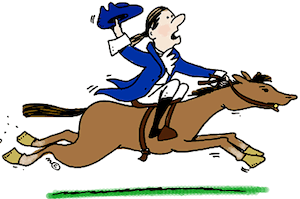248 years ago today, a respectable Boston silversmith made a fateful ride….
Listen, my children, and you shall hear
Of the midnight ride of Paul Revere,
On the eighteenth of April, in Seventy-five;
Hardly a man is now alive
Who remembers that famous day and year.
I’m sure we all “remember” those opening lines of “Paul Revere’s Ride” — maybe some of the most remembered words of Henry Wadsworth Longfellow.
The story of Paul Revere’s ride is part of American Folklore — the signal lamps in Boston’s Old North Church (“one if by land, and two if by sea,”) and then Revere’s riding like a madman, shouting, “The British are coming!” Is that really how it happened?

Well,, Longfellow’s poem about Paul Revere’s urgent ride on the eve of the battle of Lexington and Concord was inspired by local places and historic events, but he took significant poetic license with the historic facts.
Paul revere was certainly a hero and a patriot, but the honor of warning the countryside needs to be shared with a few other riders. Revere’s ride was actually prompted by Dr. Joseph Warren, who sent him to warn Concord of the impending attack, but also asked him to stop in Lexington to warn John Hancock and Samuel Adams that British troops were planning to arrest them. Warren had already sent one messenger, Williams Dawes, to Lexington — Dawes and a third messenger, Samuel Prescott aren’t mentioned in Longfellow’s poem.
Anyhow, here’s what (maybe) really happened…..
In 1775, Paul Revere was a respectable silversmith — by day, and he was also part of a rebel group that gathered intelligence on British troop movements (whenever they could.) Boston was crawling with British soldiers — not too unusual because the colonies were considered part of England at the time. But a revolution was brewing, and tension between the British soldiers and the Americans was high.
Two days before the fateful ride, Revere and his friends designed a warning system using lantern signals so they could communicate in case the British blocked the roads between towns. Turns out they’d need the warning signals sooner than they knew. The British found out that the rebels had a store of munitions near Concord and intended to march on the town, and do exactly what the Americans were afraid of — set up patrols along the road to keep messengers from spreading the news.
On April 18, 1775, Revere and a compatriot, Dr. Joseph Warren, heard about the British plan. Dr. Warren called a secret informant (rumor has it that the informant was actually the American wife of British General Gage) and verified that the British intended to burn the mutations at Concord and arrest some of the leaders of the budding revolution. Warren asked Revere to ride to Lexington to warn the leaders, John Hancock and Samuel Adams, of the danger.
Knowing that the soldiers might stop Revere, Dr. Warren also sent Williams Dawes and and Samuel Prescott with the same message, by different routes. Revere stopped by the Old North Church on the way, to tell the men there to hang two lanterns in the church steeple as a signal — the British were taking the shortcut across Boston Harbor to Cambridge, the quickest way to get to Concord. Revere crossed the Charles River in a small boat, mounted a speedy horse, and raced off. He was chased by redcoats, but he managed to outrun them. He arrived at Lexington around midnight and delivered his message to Adams and Hancock — not “The British are coming!” but “The Regulars (i.e., British troops) are coming out.”
All along the way from Boston to Lexington, Revere sent other messengers wherever he could find them. They spread the word in every direction, and by early morning, church bells, drums, and guns were sounding the alarm throughout the colony.
But after Revere had delivered his message in Lexington the night before, he had no way of knowing how far the word might spread, so he continued on, aiming straight for Concord — and the British army. He was joined by Dawes and Prescott. The three visited every house along the way, knocking on doors, asking the men inside to send riders down other roads to spread the news — the British soldiers were on their way.
Halfway to Concord, some “Regulars” stopped them — Dawes was thrown by his horse, Prescott vanished into the night and Revere was captured. Since Paul revere was something of a patriot celebrity, his captors recognized him. They questioned him — at gunpoint — and he told them the truth, about the British secret mission and the American militia response. The British soldiers rode Revere along with several other captured rebels back to Lexington, but as they neared the town, they heard gunfire and realized they’d better warn their commanders about the militia — they released the prisoners and took off.
Paul Revered arrived back in Lexington just as the local militia was forming up to meet the British troops. So he made it just in time to hear that famous “shot heard ‘round the world.” The first shot of the Revolutionary War.
— 30 —
